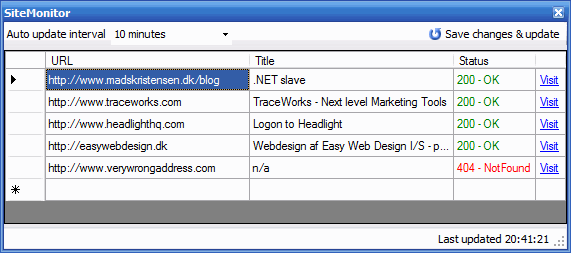For quite a while now, I have needed a simple website monitoring tool that would check the uptime of my websites. There are a lot of different ones on the Internet, some are free and some are very expensive. All the ones I found share the same complexity and that doesn’t work for me. So after browsing the web for a while to find a suitable tool I gave up empty handed. I had to write the tool my self.
This is what I wanted
- Automatic start-up
- Multi website support
- Check both HTTP status and title tag
- Balloon tip notifications
- Systray application
- Install and forget
- Low impact and high performance
This is what I didn’t need
- E-mail notifications
- History feature
- Server installation
The end result is this very simple but very powerful application that does nothing more than it is supposed to do.

It checks websites quietly in the background and pops a balloon tip if a site doesn’t return HTTP status “200 - OK”.

The reason why I chose not to include a history and email/SMS notification feature is because those features are not useful if you sit in front of your computer all day. Then a simple balloon notification would be much less obstrusive. If I’m not in front of my computer I can’t fix any issues on the websites anyway and I don’t want messages on my phone in the weekend.
Download
Site Monitor installer (398 KB)
C# source code (39 KB)
The Visual Studio 2005 launch improved so many things from older versions – some big and some small. Yet somehow it is always the small things you remember. The 2005 release is superior in almost any aspect except one – it is missing the “Create GUID” menu item. The older versions had it and even though it is not the most widely used feature, it is something I’ve been missing many times.
Even my boss got so annoyed that he built a console application and put it in C:\Windows\System32 in order to access it easily through Start –> Run. Later we learned about this wonderful website www.newguid.com but we already had the console application, so that was a little too late. As you can see, this feature has been greatly missed.
Microsoft realized they were on thin ice by removing the feature, so they made a wise decision in Service Pack 1 for Visual Studio 2005. Can you guess what it is?
They brought it back!
And not only is it back, it is also a little bit better. A GUID is a GUID is a GUID, I know, but somehow it just feels better. I would like to thank Microsoft for putting the feature back in Visual Studio, but that would be like thanking the dry cleaners for returning your pants a year too late.
You can find it in the menu under Tools –> Create GUID, just like in the old times.

